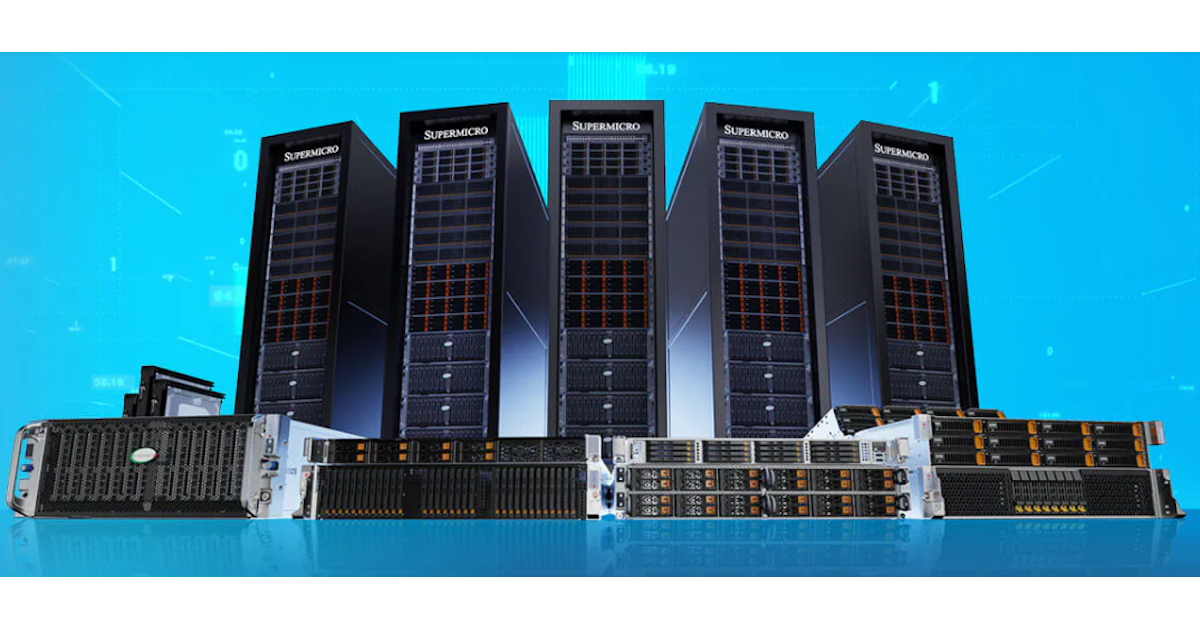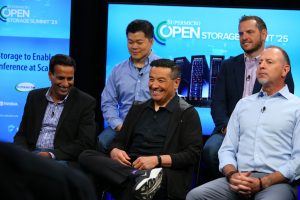 AI
AI
 AI
AI
 AI
AI
The enterprise data storage world is undergoing a transformation as IT vendors rethink how their offerings handle both the volume and complexity of artificial intelligence workloads.
It’s a transition that requires new approaches to enable faster data retrieval and support the need for AI systems to process and retain large amounts of relevant information instantaneously. Storage technology is evolving with the AI era, providing solutions for fluctuating workloads and tools that can support inferencing, graphics processing unit utilization and smarter data access.

Supermicro and industry partners discuss modern enterprise data storage needs with theCUBE.
“Storage plays a big part in making sure that your data is accessible, that it’s stored on the right tier, that you’re governing the information in the right way and leveraging best practices around how we protect that information,” said Cliff Madru, vice president of Iron Cloud and data services at Iron Mountain Inc., in conversation with theCUBE. “Being able to unlock the power of some of that data [is also crucial], both bringing it to the right tier of storage and then, of course, being able to leverage the right tools within generative AI.”
Madru spoke with theCUBE’s Rob Strechay during the Supermicro Open Storage Summit, an exclusive broadcast on theCUBE, SiliconANGLE Media’s livestreaming studio. The event featured interviews with executives from leading companies in the storage community who discussed software-defined storage, including AI from agentic to retrieval-augmented generation, data lakes and lakehouses, generative AI, app modernization, storage-as-a-service and many other topics. (* Disclosure below.)
Here’s a short clip from theCUBE’s interview with Cliff Madru, part of SiliconANGLE’s and theCUBE’s coverage of the Supermicro Open Storage Summit:
Plus, here’s three key insights you may have missed from theCUBE’s exclusive broadcast:
As SiliconANGLE analysts have noted, the spotlight on inferencing highlights an important inflection point in AI adoption, where vendors and enterprises are exploring diverse hardware and software stacks. This shift is reshaping how enterprises think about and build data storage systems as models become increasingly complex.
“With inference, it turns out there are two things that are driving the need for storage,” said John Kim, director of storage marketing at Nvidia Corp., in a discussion during the event. “The first is what we call RAG … retrieval augmented generation. That means the query can go into a semantic search, and it can retrieve related documents, real-time documents that could be from just a few hours ago. The other thing that drives the need for storage and AI inference is KV cache. As the queries get longer, if you have agentic AI, if you are using RAG, the context or the input sequence length gets longer … and longer, and it takes more and more time to compute this.”
Here’s a short clip from theCUBE’s interview with John Kim:
KV, or key-value cache, is a memory optimization technique that can be used to accelerate inferencing for large language models. Storage vendors such as Western Digital Corp. are focused on providing the high-performance infrastructure needed for efficient KV cache management.

Experts from Supermicro, DDN, AMD and Western Digital talk with theCUBE about building data storage infrastructure capable of powering agentic AI at scale.
“2025 is really the year of inferencing and agentic AI because we were actually severely under-calling the amount of compute and storage that inference and agentic AI was going to translate into,” said Praveen Midha, director of segment and technical marketing — data center flash — at Western Digital, in one panel discussion. “What we see is that inference is really a two-stage process. There is a pre-fill and there’s a decode. Pre-fill is really where you take the input tokens, you start building up the context in this intermediate buffer called the [key value] cache, and then on the decode side, you actually start outputting tokens, and then you also take these tokens and build it back into the KV cache to really hold all the context.”
Here’s a short clip from theCUBE’s interview with Praveen Midha:
For Supermicro, AI inferencing is part of a broader set of solutions geared for hybrid environments that enterprise IT customers want. Optimizing hardware becomes a central requirement for delivering a comprehensive infrastructure that can support AI needs.
“The AI evolution is driving the high demand for optimized hardware, especially for inference and real-time applications, which requires high-performance for compute, networking [and] storage,” said Junxia Zhou, product manager at Supermicro, in an appearance during the broadcast. “Enterprises want an end-to-end AI infrastructure. A solution can simplify the deployment, no matter if it is on-premises, in hybrid environments or the cloud.”
Here’s a short clip from theCUBE’s interview with Junxia Zhou:
GPUs for high-end AI processing can be pricey, with some running between $25,000 and $40,000 per unit. These costs make it essential that storage does not become a bottleneck in the AI pipeline.
Kanchan Mirani, senior director of strategic marketing at Nutanix Inc., spoke about the importance of GPUs in AI infrastructure and his firm’s efforts to benchmark data storage performance during the event.
“The first thing people tend to think about when they think about infrastructure for AI is GPUs,” Mirani said. “They say, ‘Well, I’ve got my GPU. I’ve got my infrastructure in place.’ But between the AI accelerators, be it GPUs, [tensor processing units] or [neural processing units], [central processing units] and getting an AI application to production at enterprise-grade, there’s a big gap. The goal was to see how many GPUs you can saturate, get 90% utilization from them, how much can you scale to, and with Nutanix Unified Storage, we were able to scale to over 1,000 GPUs and saturate those GPUs.”
Here’s a short clip from theCUBE’s interview with Kanchan Mirani:
Building storage systems that support GPU scaling is also a key objective for VAST Data Inc. The VAST AI Operating System allows users to capture structured and unstructured data and then contextualize it for AI by supporting multiple GPUs.

Industry experts from Supermicro, Nvidia, VAST, Solidigm, Graid and Voltage Park discuss AI and data storage.
“We founded our whole company on this disaggregated, shared-everything architecture,” said Phil Manez, GTM execution lead at VAST Data, during an interview with theCUBE. “We have to be able to support hundreds of thousands of GPUs in a single cluster, and we are literally seeing exabyte-scale deployments in single clusters now as we’re bringing together all of this data.”
Here’s a short clip from theCUBE’s interview with Phil Manez:
The need for exabyte-scale deployments has led GPU providers such as Nvidia to implement certification programs that analyze storage partner platforms according to strict criteria. An example of this can be seen in DataDirect Networks Inc., which recently completed Nvidia’s certification program for its AI400X3 scalable data storage offering as part of the EXAScaler platform.
“With the partnership of Nvidia and Supermicro, we at DDN have had the privilege to service a number of our AI customers at scale through the high-performance DDN EXAScaler storage capabilities,” said Balaji Venkateshwaran, vice president of AI product management at DataDirect Networks, during a panel discussion. “The throughput of tokens, time to first token, the performance and low latency characteristics … DDN EXAScaler specifically has had a multi-generation proven track record in this. We’ve been able to service a number of happy customers at scale, including GPU deployments as large as 100,000-plus GPUs.”
Here’s a short clip from theCUBE’s interview with Balaji Venkateshwaran:
GPUs get much of the AI news coverage these days. Yet, to hear storage practitioners describe the reality in today’s IT world, it’s all about data. Storage is fueling the AI data machine.
“Storage is the critical enabler of all the data that’s out there,” said Shiva Gurumurthy, global partner marketing manager of database and analytics at Advanced Micro Devices Inc., during a panel appearance. “When we think of AI, we think a lot about compute, but it’s really the disks and the infrastructure behind it that’s running a lot of data today. Obviously, GPUs do a lot of training these days. But to keep it fed with a lot of data, it’s actually the storage devices that are doing it on a daily basis.”
Here’s a short clip from theCUBE’s interview with Shiva Gurumurthy:
Storage’s influence on AI and data is manifesting itself in next-generation solutions that address the friction that keeps distributed data tied to physical infrastructure, a process known as data gravity. Hammerspace Inc. is tackling this problem with its AI data platform, built on a high-performance parallel file system supporting both NFS 4.2 and S3 APIs

Tony Asaro of Hammerspace joined executives from Nvidia, Supermicro, Cloudian, and Solidigm to discuss data storage.
“We have this concept called ‘AI Anywhere,’” said Tony Asaro, chief strategy and business development officer of Hammerspace, in a discussion during the broadcast. “The idea is that your data is distributed. What Hammerspace has done is that we have eliminated data gravity. What we do … is we untether the data from the physical layer, we make sure we do that with a high-degree of intelligence, control, security and specificity, meaning that we have file granular control over your data, where it’s orchestrated and where you want to move it so that you get the data where you need it and when you need it.”
Here’s a short clip from theCUBE’s interview with Tony Asaro:
Another storage company seeking to overcome the constraints of physics is Solidigm, a trademark of SK Hynix NAND Products Solutions Corp. (d/b/a/ Solidigm). NAND flash memory is a non-volatile storage technology that is designed to reduce the cost per bit and increase maximum chip capacity, providing higher endurance, power efficiency and density, according to Ace Stryker, director of market development at Solidigm.
“There’s no AI without data; there’s no data without infrastructure and there’s no infrastructure without efficiency,” he said during the event. “There are a lot of things that go into building an efficient data center. Folks may not realize that storage can account for a lot of that space and a lot of that power consumption if it’s not optimized. If you’re using legacy storage, there’s probably a lot of room for improvement, and that’s where products like [Solidigm]…come in.”
Here’s a short clip from theCUBE’s interview with Ace Stryker:
(* Disclosure: TheCUBE is a paid media partner for the Supermicro Open Storage Summit. Neither Supermicro, the sponsor of theCUBE’s event coverage, nor other sponsors have editorial control over content on theCUBE or SiliconANGLE.)
Support our mission to keep content open and free by engaging with theCUBE community. Join theCUBE’s Alumni Trust Network, where technology leaders connect, share intelligence and create opportunities.
Founded by tech visionaries John Furrier and Dave Vellante, SiliconANGLE Media has built a dynamic ecosystem of industry-leading digital media brands that reach 15+ million elite tech professionals. Our new proprietary theCUBE AI Video Cloud is breaking ground in audience interaction, leveraging theCUBEai.com neural network to help technology companies make data-driven decisions and stay at the forefront of industry conversations.